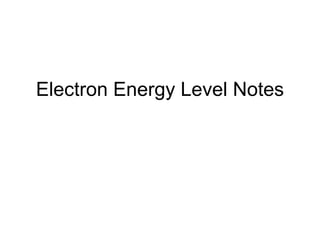
Electron_Energy_Level_Notes.ppt
- 1. Electron Energy Level Notes
- 2. Electron Energy Level Notes • Electrons do not travel around the nucleus of an atom in orbits • They are found in energy levels at different distances away from the nucleus. (kind of like shells or layers).
- 3. The Quantum Mechanical Model of the Atom (cont.) The wave function predicts a three-dimensional region around the nucleus called the atomic orbital.
- 4. Hydrogen Atomic Orbitals Principal quantum number (n) indicates the relative size and energy of atomic orbitals. n specifies the atom’s major energy levels, called the principal energy levels. Electrons cannot exist between energy levels (just like the rungs of a ladder).
- 5. Electron Energy Level Notes • Energy levels are broken up into sublevels: • There are at least 4 possible types of sublevels—given labels: s, p, d, or f •
- 6. Hydrogen Atomic Orbitals (cont.) Energy sublevels are contained within the principal energy levels. 1 = 1sublevel ,s 2 = 2sublevel ,sp 3 = 3sublevel ,spd 4 = 4sublevel ,spdf
- 8. Electron Energy Level Notes • Only a certain number of electrons may exist in an energy level, but the number varies. It can be determined by: • # of electrons in level = 2 x (# of energy level)2 • Therefore: • energy level 1 = 2 (1)2 = 2 • energy level 2 = 2 (2)2 = 8 • energy level 3 = 18 • energy level 4 = 32 • etc...
- 9. Electron Energy Level Notes • In each energy level, electrons fill sublevels in a certain order • Level 1: • only has one s sublevel (a spherical shape) • 2 electrons may fit in this sublevel--each one has an opposite “spin”, allowing them to take up the same space • Pauli exclusion principle—no more than 2 electrons may be found in the same orbital (“orbital” means a particular location)
- 10. s-Orbital Image
- 11. Electron Energy Level Notes • Level 2: • has two sublevels: s and p • 2 electrons in s • there are 3 different p orbitals, and may hold 2 electrons each—6 total. (look at shape on p. 154-- imagine how they can fit together) • total of 8 overall in Level 2
- 12. p-Orbital Image
- 13. Electron Energy Level Notes • Level 3: • has 3 sublevels: s, p, and d • 2 electrons in s • 6 electrons in p • there are 5 different d orbitals, and 2 electrons can fit in each—total of 10. (look at picture of d orbitals, imagine how they can fit together) • total of 18
- 14. d-orbital notes
- 15. Hydrogen Atomic Orbitals (cont.) Each energy sublevel relates to orbitals of different shape.
- 17. Electron Energy Level Notes • Level 4: • has 4 sublevels: s, p, d , and f • 2 electrons in s • 6 electrons in p • 10 electrons in d • 14 electrons in f (7 different orbitals for f) • total of 32
- 18. Hydrogen Atomic Orbitals (cont.)
- 19. Electron Energy Level Notes • The order that electrons fill up orbitals does not follow the logical order of all 1’s, then all 2’s, then all 3’s, etc. • They follow the order found based on certain rules.
- 21. • ATOMIC # = #p+ = #e-
- 23. Electron Energy Level Notes • An easy way to remember this is to use the periodic table--it is arranged to show how these orbitals are filled.
- 24. Order of Orbitals—Periodic Table
- 25. Ground-State Electron Configuration The arrangement of electrons in the atom is called the electron configuration. The aufbau principle states that each electron occupies the lowest energy orbital available.
- 26. Ground-State Electron Configuration (cont.) The Pauli exclusion principle states that a maximum of two electrons can occupy a single orbital, but only if the electrons have opposite spins. Hund’s rule states that single electrons with the same spin must occupy each equal-energy orbital before additional electrons with opposite spins can occupy the same energy level orbitals.
- 27. Electron Energy Level Notes • Hund’s rule is used for filling orbitals with electrons. It states that only one electron will be put in each orbital of a sublevel until all of them are filled, and after that, they may be paired up until the sublevel is full.
- 28. Section 5-3 Ground-State Electron Configuration (cont.)
- 29. 3py 3pz
- 30. Section 5-3 Ground-State Electron Configuration (cont.) Noble gas notation uses noble gas symbols in brackets to shorten inner electron configurations of other elements.
- 31. Section 5-3 Ground-State Electron Configuration (cont.) The electron configurations (for chromium, copper, and several other elements) reflect the increased stability of half-filled and filled sets of s and d orbitals.
- 32. Section 5-3 Valence Electrons Valence electrons are defined as electrons in the atom’s outermost orbitals—those associated with the atom’s highest principal energy level. Electron-dot structure consists of the element’s symbol representing the nucleus, surrounded by dots representing the element’s valence electrons.
- 33. Section 5-3 Valence Electrons (cont.)